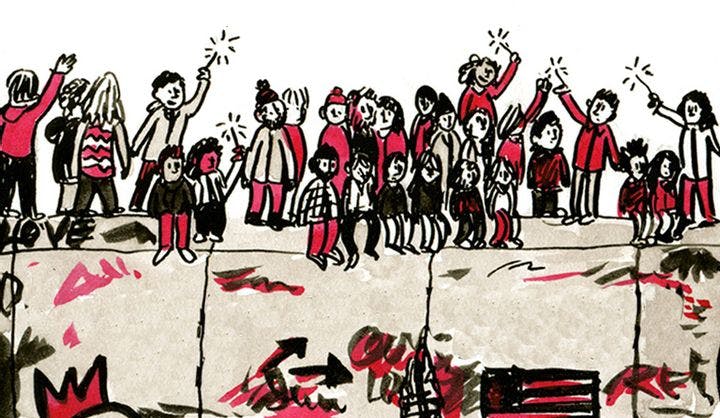Fall 2014
How two-thirds of the Berlin Wall ended up in the U.S.
– Anne Elizabeth Moore and Melissa Mendes
The Berlin Wall went from a symbol of oppression to a commercial item with pieces bought and sold in the United States.

* * *
Full text below:
On November 9, 1989, after 28 years, the Berlin Wall fell in Germany.
Five days later, it emerged again at KDWB FM in Saint Paul, Minnesota. That’s right folks, we're giving away a piece of the Berlin Wall to the 25th Caller!
The press was shocked by the crass commercial appearance of communist keepsakes… for two weeks. Then Christmas season began.
Suddenly, bits of the barrier that had kept families separated for 28 years — and brought death to at least 138 individuals — seemed like a decent holiday gift to a capitalist nation with a rising divorce rate and an increasingly alienated youth population. By then, department stores in most U.S. cities were selling bits of the Wall, too.
Many Americans took credit for its fall. But only one was poised to profit from it: New Jersey-based contractor Joseph Sciamarelli.
When the Wall fell, a friend sent Sciamarelli a piece he'd chipped off by hand. A CNN report of the event caught the eye of an official from Limex-Bau, the German company contracted to demolish the Wall. They offered him the exclusive right to distribute large pieces in the U.S. for $35,000.
Sciamarelli bought individual pieces for $35-$50,000 and sold them for $50-$100,000 — around twice what he'd paid for them. But sales were slow.
So Sciamarelli called former U.S. President Ronald Reagan and reminded him of his contribution to its fall. Reagan purchased one piece, then another.
Other presidents quickly followed suit. So did private collectors and other public institutions. Close to two-thirds of the Wall now sits on domestic soil.
Sciamarelli has been behind more than three-quarters of all sales of the Berlin Wall in the U.S. He claims his entrepreneurship is driven by the horrors of socialism. He said he wanted to ensure that such events — which he did not personally experience — would by unthinkable for future generations to repeat.
It's become a tradition for German politicians to give pieces of the Wall to various nations in need of a visual metaphor about barriers: their fall, their existence, their stupidity. Progress. Capitalism.
A piece at the Western Brown Line "El" stop in Chicago is also a reference to the traditional German population in the area. They had largely moved away by the time the Wall was installed there, although marketing campaigns for the neighborhood are still German-themed. But that Wall segment is also a comment on borders. Western Avenue used to be the westernmost edge of the city. Now the symbol of East Germany is on Western.
Tourist shops in Berlin still sell small bits of Wall. They went at a rapid clip for a decade and a half, but a few years ago, all the most colorful chunks ran out. The boring grey chunks of the Wall weren't selling.
So shopkeepers recalled them, spray-painted them, and redisplayed them. Sales picked up.
Some stateside appearances of the Wall, such as the one in the Wings of Peace and Freedom Park in Ronald Reagan's hometown of Dixon, IL, are fake, rebuilt, or testaments — leading passerby to wonder what was really at stake for Americans that they must regularly reconstruct the supposedly reviled entity.
It is popular, for example, for grade schools in Wisconsin to reconstruct the Berlin Wall out of cardboard and slather it with colorful but historically inaccurate slogans (Save the Whales!; Never Forget: September 11th).
Marketing agencies, too, reconstruct the Wall, then invite clients to tear it down. The Wall here represents barriers to unlimited sales.
Recently, Sciamarelli bemoaned the lack of riches the enterprise brought him, claiming he only ever made "a couple hundred thousand dollars" from sales of the Berlin Wall, according to a 2009 piece by Jacquelyn Ryan in Medill Reports - Chicago:
“I met five living presidents. My wife had lunch with Nancy Reagan, Barbara Bush, and Betty Ford … I ended up in publishing because of contacts I made at the White House and Pentagon. So those were the biggest profit and reward from Berlin.”
But Sciamarelli brought a socialist legacy to America — and made a buck off of it.
* * *
Anne Elizabeth Moore is a journalist and critic whose work has been granted two Fulbright awards, a UN Press Fellowship, and a USC Annenberg/Getty Arts Journalism Fellowship. Her book Cambodian Grrrl received a 2012 Lowell Thomas Travel Journalism Award and Unmarketable was Mother Jones’ 2007 Best Book. She writes for The Baffler and Salon, is an editor at the Los Angeles Review of Books, and she teaches in the Visual Critical Studies department at the School of the Art Institute of Chicago.
Melissa Mendes is a cartoonist, illustrator, and the Illustrations Editor at Narratively. She lives and works in Hancock, Massachusetts.
This story was created in partnership between The Wilson Quarterly and Narratively.
